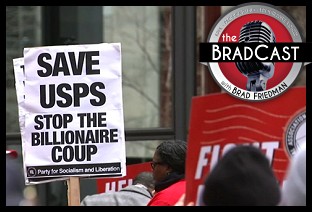 The political world exploded tonight with the stunning reported defeat of Republican House Majority Leader Eric Cantor to little-known "Tea Party" candidate Dave Brat.
The political world exploded tonight with the stunning reported defeat of Republican House Majority Leader Eric Cantor to little-known "Tea Party" candidate Dave Brat.
Cantor's loss was so unexpected that Democrats didn't even bother to nominate anyone to run in Virginia's 7th Congressional District until last night, reportedly during a conference call, when they decided to put up a professor named Jack Trammell (from the same Randolph-Macon College where Brat works) as their nominee, just before today's deadline.
"A conservative challenger is expected to fall far short of defeating House Majority Leader Eric Cantor (R-Va.) in Tuesday's congressional primary," wrote Rachel Weiner in Virginia's local paper known as the Washington Post just this morning. "The question in this race is how large Cantor's margin of victory will be."
So, there's more than enough speculative analysis complete guess work out there for you elsewhere about what all of this portends, from the same political pundits and geniuses and well-sourced insiders who had no clue that Cantor was about to become famous as the first sitting House Majority Leader to lose in a primary race since either 1899 or...forever, depending on who you listen to.
But, pretty much just as soon as it appeared that Cantor was about to be announced the "loser" in a blowout of an election late today, questions started coming in to us, via Twitter and elsewhere, with concerns about the integrity of the reported results and if there could have been any chicanery behind them...
Well, good question, of course, given that the reported results in this earthquake of an election haven't actually been verified by any human beings. Rather, the results, from 9 different counties (and one city) that make up the impossibly gerrymandered 7th District, which Cantor helped carve out for himself, are all based on the numbers reported by the oft-failed, easily-manipulated computer tabulators from the alphabet soup of different types of electronic voting and tabulation systems used in each of the separate jurisdictions that comprise the district.
More on those systems in a moment. Here are the unofficial results --- district-wide totals and then county-by-county --- of the VA-07 election as reported at the Virginia State Board of Elections website as of 11:59pm ET tonight, with 100% of precincts reporting...

[NOTE: The numbers above are still unofficial, and do not include absentee or provisional ballots that have not yet been tallied as of the end of Election Night.]
As to the type of voting systems used in each jurisdiction, there are --- as in the rest of the country --- principally, two different types used: optically-scanned paper ballots systems (in two of the largest jurisdictions) and 100% unverifiable Direct Recording Electronic (DRE, usually touch-screen) systems in all of the others. The DRE systems are made by several different companies, the paper ballot systems are made by ES&S, the nation's largest voting system vendor.
All of the voting systems used in VA-07 have been found by computer scientists and e-voting experts to be vulnerable to error, malfunction and malfeasance, and --- whether it's a paper-based system or a 100% unverifiable touch-screen system --- each one uses a computerized central tabulator to total up all of the numbers from the vulnerable memory cards deployed in the systems at each of the various precincts in the jurisdiction.
Paper-ballot op-scan systems, unlike DREs, are verifiable after an election, if any human beings ever bothers, or are allowed, to examine the paper ballots by hand to make sure the computers tallied votes correctly. Paper-ballot op-scan systems can fail to report accurate results. For example, three elections were incorrectly tabulated by the paper-ballot op-scan system in Palm Beach County, FL in 2012. The computer errors there resulted in two losing candidates being declared the "winner" on election night by the computers. The problem was only discovered thanks to a sharp-eyed Election Supervisor before the actual winners of the elections were ultimately determined via a court-ordered hand-count of the paper ballots.
Hand-counting paper ballots is the only way to know if a paper-ballot op-scan system has tabulated results accurately or not. Mistallied ballots are not uncommon with such systems.
With all of that said, here are the types of voting systems used in each of the jurisdictions in VA-07, as sorted by the number of votes reportedly cast in each one, according to the same unofficial totals as shown above...

And here are the same numbers, as sorted by the margin of victory in each jurisdictions for Brat...

[NOTE: Info on the voting systems reported here was originally taken from VerifiedVoting.org's database, last updated in 2012. We have since updated the chart and article with information from the VA State Board of Elections [XLS], reflecting the voting system change from the ES&S M100 to the ES&S DS200 in Chesterfield County after 2012. ]
As you can see, two of the three largest voting jurisdictions respected their voters enough to allow them to use hand-marked paper ballots, tallied by precinct-based ES&S M100 and DS200 op-scan systems. If anyone wanted to verify the results of the 26,034 votes reported by the tabulators in Chesterfield and Hanover Counties, they could do so (presuming the chain of custody for ballots is secure, and they were allowed to do so by law.)
No votes --- none of the 38,974 reportedly cast --- from any of VA-07's other 8 jurisdictions can ever be verified as having been recorded accurately as per the intent of any voter. Not even one vote. So those numbers are lost forever. Whatever the computers reported is what the results will be, whether they are accurate or not, and there's nothing anybody can ever do about it.
As to those M100s and DS200s used in the two largest counties today, The BRAD BLOG wrote about the same ES&S M100s back in 2008, when Oakland County, MI, was trying to get help from the U.S. Election Assistance Commission concerning the same precinct-based op-scan systems which, during pre-election testing, the county said, had "yielded different results each time" the "same ballots were run through the same machines."
In 2008, West Virginia also reported problems with their M100s. In 2010, the newer ES&S op-scan systems --- supposedly better ones --- the DS200s were found to have mistallied votes in New York City, including a failure rate of 70% in some precincts.
As we've noted many times, problems with voting systems and tabulators often show up only days --- and sometimes weeks and months (or even years, as with the NYC incident cited above) --- later. Late last year, in Virginia, coincidentally enough, some 3,000 votes were discovered to have been left out from the final computer tabulator totals in the exceedingly close statewide race for Attorney General. Those missing votes were only noticed in the days following the election, as citizen experts pored over the reported results, attempting oversight, and looking for potential anomalies and inaccuracies in the incredibly close contest.
Three days ago, the Washington Post reported that Cantor's internal polling showed him 34 points ahead of Brat. Tonight, it's a given among the pundit class, that those numbers were simply wrong and tonight's completely unverified computer-reported results are correct, showing Cantor losing instead by more than 11 points.
Those results may be correct. Or they may not be. Nobody actually knows. Given the broad reported victory by Brat in several different counties, on several different voting systems, it seems, at first glance, unlikely that malfunction or malfeasance gave him the edge. Still, nobody actually knows that, as election results, even where they can be verified by human beings, will likely never be.
Given the surprising "blow-out" "upset" nature of tonight's reported victory of Brat over Cantor, the pundit class will now twist themselves into pretzels to backwards engineer reasonable "explanations" for Cantor's defeat, no matter how thin the evidence to support their theories. We've seen it before. Too many times, in fact.
After pretending to know why the results were the opposite of what they thought they'd be a day earlier, most pundits will then quickly focus on the political ramifications of the reported results, rather than bother to try and verify any of them to make sure they are actually accurate and that the Republican primary voters of Virginia actually elected who they now think they elected as their nominee for the U.S. House of Representatives.
UPDATE 6/11/2014, 10:30am PT: True to form and prediction, the pundit class is hard at work offering backwards engineered explanations for the completely unverified results in a race where the powerful incumbent is said to have lost to a virtual unknown, even after outspending him 20 to 1.
Since last night, we have been instructed by the political professionals that it was all due to Cantor's position in favor of "amnesty"! No, it was his lack of support for immigration reform! No, it was his lack of support for his "conservative" colleagues! No, it was cross-over voting by meddling Democrats! No, it was GOP anti-Semitism! No, it was the power of Rightwing Talk Radio! No, it was corruption and crony-capitalism!
Any of those explanations may be correct. But, the fact is, it's all guesswork. None of them have a clue why Cantor theoretically lost, but they're willing to say anything no matter how little evidence there is to support it. Anything, that is, except for informing the electorate of the fact that nobody actually knows for sure if Cantor lost or not, because nobody has bothered to verify any of the results as accurate.


 Vets Push Back at Trump, Musk Plan to Slash Health Care, 80K V.A. Jobs: 'BradCast' 3/27/25
Vets Push Back at Trump, Musk Plan to Slash Health Care, 80K V.A. Jobs: 'BradCast' 3/27/25 'Green News Report' 3/27/25
'Green News Report' 3/27/25
 Signal Scandal Worsens for Trump, GOP; Big Election Victories for Dems in PA: 'BradCast' 3/26/25
Signal Scandal Worsens for Trump, GOP; Big Election Victories for Dems in PA: 'BradCast' 3/26/25 'Emptywheel' on Why Trump NatSec Team Should 'Resign in Disgrace' After Signal Chat Debacle: 'BradCast' 3/25/25
'Emptywheel' on Why Trump NatSec Team Should 'Resign in Disgrace' After Signal Chat Debacle: 'BradCast' 3/25/25 'Green News Report' 3/25/25
'Green News Report' 3/25/25 Postal Workers Union Prez: USPS 'Belongs to the People, Not the Billionaires':
Postal Workers Union Prez: USPS 'Belongs to the People, Not the Billionaires': Sunday 'Suddenly Conceivable' Toons
Sunday 'Suddenly Conceivable' Toons We're ALL Voice of America Now: 'BradCast' 3/20/25
We're ALL Voice of America Now: 'BradCast' 3/20/25 'Green News Report' 3/20/25
'Green News Report' 3/20/25 What Trump's 'Timber Production Expansion' Means (and Costs): 'BradCast' 3/19/25
What Trump's 'Timber Production Expansion' Means (and Costs): 'BradCast' 3/19/25 Courts Largely Holding Against Trump, Musk Lawlessness: 'BradCast' 3/18/25
Courts Largely Holding Against Trump, Musk Lawlessness: 'BradCast' 3/18/25 'Green News Report' 3/18/25
'Green News Report' 3/18/25 Chief VOA Reporter on Outlet Falling Silent First Time Since 1942: 'BradCast' 3/17/25
Chief VOA Reporter on Outlet Falling Silent First Time Since 1942: 'BradCast' 3/17/25 Sunday 'The Usual' Toons
Sunday 'The Usual' Toons 'Green News Report' 3/13/25
'Green News Report' 3/13/25 Trump EPA Unveils Plans to Endanger, Sicken Americans: 'BradCast' 3/13/25
Trump EPA Unveils Plans to Endanger, Sicken Americans: 'BradCast' 3/13/25 Trump Nixed Enforce-ment Against 100 Corp. Lawbreakers: 'BradCast' 3/12/25
Trump Nixed Enforce-ment Against 100 Corp. Lawbreakers: 'BradCast' 3/12/25 Bad Day for 'Strongmen': 'BradCast' 3/11
Bad Day for 'Strongmen': 'BradCast' 3/11 WI Election Could Flip Supreme Court Control, Musk Jumps In: 'BradCast' 3/10
WI Election Could Flip Supreme Court Control, Musk Jumps In: 'BradCast' 3/10 'What Else Could a Russian Asset Do That Trump Hasn't?': 'BradCast' 3/6/25
'What Else Could a Russian Asset Do That Trump Hasn't?': 'BradCast' 3/6/25 The Longest, Dullest, Most Lie-Filled 'SOTU' Ever: 'BradCast' 3/5/25
The Longest, Dullest, Most Lie-Filled 'SOTU' Ever: 'BradCast' 3/5/25 Trump Bad for Biz... and Farmers... and Nat'l Parks... and...: 'BradCast' 3/4/25
Trump Bad for Biz... and Farmers... and Nat'l Parks... and...: 'BradCast' 3/4/25 Trump Targeting 50% Cuts, Office Closures at Social Security: 'BradCast' 3/3/25
Trump Targeting 50% Cuts, Office Closures at Social Security: 'BradCast' 3/3/25
 VA GOP VOTER REG FRAUDSTER OFF HOOK
VA GOP VOTER REG FRAUDSTER OFF HOOK Criminal GOP Voter Registration Fraud Probe Expanding in VA
Criminal GOP Voter Registration Fraud Probe Expanding in VA DOJ PROBE SOUGHT AFTER VA ARREST
DOJ PROBE SOUGHT AFTER VA ARREST Arrest in VA: GOP Voter Reg Scandal Widens
Arrest in VA: GOP Voter Reg Scandal Widens ALL TOGETHER: ROVE, SPROUL, KOCHS, RNC
ALL TOGETHER: ROVE, SPROUL, KOCHS, RNC LATimes: RNC's 'Fired' Sproul Working for Repubs in 'as Many as 30 States'
LATimes: RNC's 'Fired' Sproul Working for Repubs in 'as Many as 30 States' 'Fired' Sproul Group 'Cloned', Still Working for Republicans in At Least 10 States
'Fired' Sproul Group 'Cloned', Still Working for Republicans in At Least 10 States FINALLY: FOX ON GOP REG FRAUD SCANDAL
FINALLY: FOX ON GOP REG FRAUD SCANDAL COLORADO FOLLOWS FLORIDA WITH GOP CRIMINAL INVESTIGATION
COLORADO FOLLOWS FLORIDA WITH GOP CRIMINAL INVESTIGATION CRIMINAL PROBE LAUNCHED INTO GOP VOTER REGISTRATION FRAUD SCANDAL IN FL
CRIMINAL PROBE LAUNCHED INTO GOP VOTER REGISTRATION FRAUD SCANDAL IN FL Brad Breaks PA Photo ID & GOP Registration Fraud Scandal News on Hartmann TV
Brad Breaks PA Photo ID & GOP Registration Fraud Scandal News on Hartmann TV  CAUGHT ON TAPE: COORDINATED NATIONWIDE GOP VOTER REG SCAM
CAUGHT ON TAPE: COORDINATED NATIONWIDE GOP VOTER REG SCAM CRIMINAL ELECTION FRAUD COMPLAINT FILED AGAINST GOP 'FRAUD' FIRM
CRIMINAL ELECTION FRAUD COMPLAINT FILED AGAINST GOP 'FRAUD' FIRM RICK SCOTT GETS ROLLED IN GOP REGISTRATION FRAUD SCANDAL
RICK SCOTT GETS ROLLED IN GOP REGISTRATION FRAUD SCANDAL VIDEO: Brad Breaks GOP Reg Fraud Scandal on Hartmann TV
VIDEO: Brad Breaks GOP Reg Fraud Scandal on Hartmann TV RNC FIRES NATIONAL VOTER REGISTRATION FIRM FOR FRAUD
RNC FIRES NATIONAL VOTER REGISTRATION FIRM FOR FRAUD EXCLUSIVE: Intvw w/ FL Official Who First Discovered GOP Reg Fraud
EXCLUSIVE: Intvw w/ FL Official Who First Discovered GOP Reg Fraud GOP REGISTRATION FRAUD FOUND IN FL
GOP REGISTRATION FRAUD FOUND IN FL


































